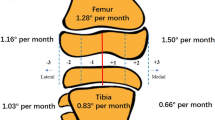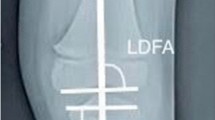Abstract
Introduction
Pediatric coronal plane knee deformities can be treated surgically using hemiepiphysiodesis. The two leading techniques used for hemiepiphysiodesis are: tension-band plates (TBP) and percutaneous transphyseal screws (PETS). We hypothesized that PETS would lead to faster guided correction of angular knee deformities than TBP.
Materials and methods
A retrospective cohort of 35 patients treated with either TBP or PETS in one medical institution was established. The cohort included both genu varum and genu valgum of both primary and secondary etiologies. We first compared the treatment groups for differences in demographic and malalignment characteristics. Then, we compared the treatment groups for differences in operation-related outcomes, radiological mechanical correction and complication rates.
Results
We found that the use of PETS, compared to TBP, was associated with a faster implantation surgery and a shorter interval between implantation and removal, i.e., faster correction. Furthermore, PETS were associated with faster correction rates of the mechanical axis deviation, lateral distal femoral angle and medial proximal tibial angle. No significant differences in complication rates were found between the two treatments.
Conclusion
PETS provided a faster correction of angular knee deformities compared to TBP at similar complication rates. Hence, PETS could be considered a superior technique for hemiepiphysiodesis.












Similar content being viewed by others
References
Kling TF Jr (1987) Angular deformities of the lower limbs in children. Orthop Clin North Am 18(4):513–527
Bruce RW Jr (1996) Torsional and angular deformities. Pediatr Clin North Am 43(4):867–881
Sass P, Hassan G (2003) Lower extremity abnormalities in children. Am Fam Physician 68(3):461–468
Greene WB (1994) Genu varum and genu valgum in children. Instr Course Lect 43:151–159
Cheema JI, Grissom LE, Harcke HT (2003) Radiographic characteristics of lower-extremity bowing in children. Radiographics 23(4):871–880. https://doi.org/10.1148/rg.234025149
Migliorini F, Rath B, Colarossi G, Driessen A, Tingart M, Niewiera M et al (2020) Improved outcomes after mesenchymal stem cells injections for knee osteoarthritis: results at 12-months follow-up: a systematic review of the literature. Arch Orthop Trauma Surg 140(7):853–868. https://doi.org/10.1007/s00402-019-03267-8
Kim SH, Djaja YP, Park YB, Park JG, Ko YB, Ha CW (2019) Intra-articular injection of culture-expanded mesenchymal stem cells without adjuvant surgery in knee osteoarthritis: a systematic review and meta-analysis. Am J Sports Med. https://doi.org/10.1177/0363546519892278(363546519892278)
Surdam JW, Morris CD, DeWeese JD, Drvaric DM (2003) Leg length inequality and epiphysiodesis: review of 96 cases. J Pediatr Orthop 23(3):381–384
Horton GA, Olney BW (1996) Epiphysiodesis of the lower extremity: results of the percutaneous technique. J Pediatr Orthop 16(2):180–182
Hosseinzadeh P, Ross DR, Walker JL, Talwalkar VR, Iwinski HJ, Milbrandt TA (2016) Three methods of guided growth for pediatric lower extremity angular deformity correction. Iowa Orthop J 36:123–127
Saran N, Rathjen KE (2010) Guided growth for the correction of pediatric lower limb angular deformity. J Am Acad Orthop Surg 18(9):528–536
Stevens PM, Maguire M, Dales MD, Robins AJ (1999) Physeal stapling for idiopathic genu valgum. J Pediatr Orthop 19(5):645–649
Zuege RC, Kempken TG, Blount WP (1979) Epiphyseal stapling for angular deformity at the knee. J Bone Joint Surg Am 61(3):320–329
Raluy-Collado D, Sanpera I, Frontera-Juan G, Ramos-Asensio R, Tejada-Gavela S (2012) Screw length in the guided growth method. Arch Orthop Trauma Surg 132(12):1711–1715. https://doi.org/10.1007/s00402-012-1615-3
De Brauwer V, Moens P (2008) Temporary hemiepiphysiodesis for idiopathic genua valga in adolescents: percutaneous transphyseal screws (PETS) versus stapling. J Pediatr Orthop 28(5):549–554. https://doi.org/10.1097/BPO.0b013e31817baab2
Shin SJ, Cho TJ, Park MS, Bae JY, Yoo WJ, Chung CY et al (2010) Angular deformity correction by asymmetrical physeal suppression in growing children: stapling versus percutaneous transphyseal screw. J Pediatr Orthop 30(6):588–593. https://doi.org/10.1097/BPO.0b013e3181e04b5d
Gottliebsen M, Rahbek O, Hvid I, Davidsen M, Hellfritzsch MB, Moller-Madsen B (2013) Hemiepiphysiodesis: similar treatment time for tension-band plating and for stapling: a randomized clinical trial on guided growth for idiopathic genu valgum. Acta Orthop 84(2):202–206. https://doi.org/10.3109/17453674.2013.782526
Wiemann JMT, Tryon C, Szalay EA (2009) Physeal stapling versus 8-plate hemiepiphysiodesis for guided correction of angular deformity about the knee. J Pediatr Orthop 29(5):481–485. https://doi.org/10.1097/BPO.0b013e3181aa24a8
Park H, Park M, Kim S, Kim H, Lee D (2018) Hemiepiphysiodesis for idiopathic genu valgum: percutaneous transphyseal screw versus tension-band plate. J Pediat Orthop 38(6):325–330. https://doi.org/10.1097/BPO.0000000000000821
Stevens P (2006) Guided growth: 1933 to the present. Strat Trauma Limb Reconst 1(1):29–35
Burghardt RD, Herzenberg JE, Standard SC, Paley D (2008) Temporary hemiepiphyseal arrest using a screw and plate device to treat knee and ankle deformities in children: a preliminary report. J Child Orthop 2(3):187–197. https://doi.org/10.1007/s11832-008-0096-y
Ghanem I, Karam JA, Widmann RF (2011) Surgical epiphysiodesis indications and techniques: update. Curr Opin Pediatr 23(1):53–59. https://doi.org/10.1097/MOP.0b013e32834231b3
Bachmann M, Rutz E, Brunner R, Gaston MS, Hirschmann MT, Camathias C (2014) Temporary hemiepiphysiodesis of the distal medial femur: MPFL in danger. Arch Orthop Trauma Surg 134(8):1059–1064. https://doi.org/10.1007/s00402-014-2032-6
Sung KH, Chung CY, Lee KM, Lee SY, Choi IH, Cho TJ et al (2014) Determining the best treatment for coronal angular deformity of the knee joint in growing children: a decision analysis. Biomed Res Int 2014:603432. https://doi.org/10.1155/2014/603432
Metaizeau JP, Wong-Chung J, Bertrand H, Pasquier P (1998) Percutaneous epiphysiodesis using transphyseal screws (PETS). J Pediatr Orthop 18(3):363–369
Stevens PM (2007) Guided growth for angular correction: a preliminary series using a tension band plate. J Pediatr Orthop 27(3):253–259. https://doi.org/10.1097/BPO.0b013e31803433a1
Paley D, Herzenberg JE, Tetsworth K, McKie J, Bhave A (1994) Deformity planning for frontal and sagittal plane corrective osteotomies. Orthop Clin North Am 25(3):425–465
Gigante C, Borgo A, Corradin M (2017) Correction of lower limb deformities in children with renal osteodystrophy by guided growth technique. J Child Orthop 11(1):79–84. https://doi.org/10.1302/1863-2548-11-160172
Kumar S, Sonanis S (2018) Growth modulation for coronal deformity correction by using eight plates-systematic review. J Orthop 15(1):168–172. https://doi.org/10.1016/j.jor.2018.01.022
Danino B, Rodl R, Herzenberg J, Shabtai L, Grill F, Narayanan U et al (2018) Guided growth: preliminary results of a multinational study of 967 physes in 537 patients. J Child Orthop 12(1):91–96. https://doi.org/10.1302/1863-2548.12.170050
Burghardt R, Herzenberg J (2010) Temporary hemiepiphysiodesis with the eight-plate for angular deformities: mid-term results. J Orthop Sci 15(5):699–704. https://doi.org/10.1007/s00776-010-1514-9
Ballal M, Bruce C, Nayagam S (2010) Correcting genu varum and genu valgum in children by guided growth temporary hemiepiphysiodesis using tension band plates. J Bone Jt Surg Br Vol 92B(2):273–276. https://doi.org/10.1302/0301-620X.92B2.22937
Guzman H, Yaszay B, Scott VP, Bastrom TP, Mubarak SJ (2011) Early experience with medial femoral tension band plating in idiopathic genu valgum. J Child Orthop 5(1):11–17. https://doi.org/10.1007/s11832-010-0310-6
Khoury JG, Tavares JO, McConnell S, Zeiders G, Sanders JO (2007) Results of screw epiphysiodesis for the treatment of limb length discrepancy and angular deformity. J Pediatr Orthop 27(6):623–628. https://doi.org/10.1097/BPO.0b013e318093f4f4
Wu Z, Ding J, Zhao D, Zhao L, Li H, Liu J (2017) Multiplier method may be unreliable to predict the timing of temporary hemiepiphysiodesis for coronal angular deformity. J Orthop Surg Res 12(1):104. https://doi.org/10.1186/s13018-017-0604-1
Spiro AS, Babin K, Lipovac S, Rupprecht M, Meenen NM, Rueger JM et al (2010) Anterior femoral epiphysiodesis for the treatment of fixed knee flexion deformity in spina bifida patients. J Pediatr Orthop 30(8):858–862. https://doi.org/10.1097/BPO.0b013e3181f10297
Stiel N, Babin K, Vettorazzi E, Breyer S, Ebert N, Rupprecht M et al (2018) Anterior distal femoral hemiepiphysiodesis can reduce fixed flexion deformity of the knee: a retrospective study of 83 knees. Acta Orthop 89(5):555–559. https://doi.org/10.1080/17453674.2018.1485418
Palocaren T, Thabet AM, Rogers K, Holmes L, Donohoe M, King MM et al (2010) Anterior distal femoral stapling for correcting knee flexion contracture in children with arthrogryposis–preliminary results. J Pediatr Orthop 30(2):169–173. https://doi.org/10.1097/BPO.0b013e3181d07593
Funding
There is no funding source.
Author information
Authors and Affiliations
Corresponding author
Ethics declarations
Conflict of interest
The authors declare that they have no conflict of interest.
Ethical approval
The study was approved by the Institutional Review Board.
Additional information
Publisher's Note
Springer Nature remains neutral with regard to jurisdictional claims in published maps and institutional affiliations.
Rights and permissions
About this article
Cite this article
Shapiro, G., Adato, T., Paz, S. et al. Hemiepiphysiodesis for coronal angular knee deformities: tension-band plate versus percutaneous transphyseal screw. Arch Orthop Trauma Surg 142, 105–113 (2022). https://doi.org/10.1007/s00402-020-03602-4
Received:
Accepted:
Published:
Issue Date:
DOI: https://doi.org/10.1007/s00402-020-03602-4




